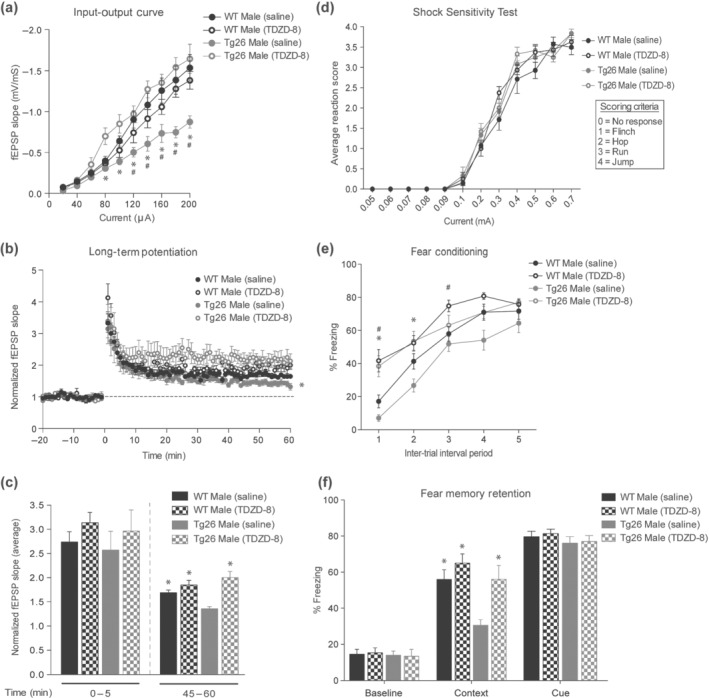FIGURE 7.

GSK3 inhibition rescues the deficits in basal hippocampal synaptic transmission,long‐term potentiation (LTP) and contextual fear memory in male Tg26 mice. (a) Input–output (IO) curves showing significant improvement in hippocampal fEPSPs in male Tg26 mice following treatment with GSK3 inhibitor (TDZD‐8; 5 mg·kg−1for 24 h) as compared to male Tg26 mice treated with saline (n = 5 for saline treated WT, n = 5 for TDZD‐8 treated WT, n = 6 for saline treated Tg26, n = 5 for TDZD‐8 treated Tg26). *P < 0.05, for Tg26 male saline vs. TDZD‐8; # P < 0.05, for Tg26 male saline vs. WT male saline, repeated measures two‐way ANOVA with Tukey's HSD correction. (b) TDZD‐8 treatment rescued the LTP deficits in male Tg26 mice as compared to the saline treated Tg26 mice (n = 5 for saline treated WT, n = 5 for TDZD‐8 treated WT, n = 6 for saline treated Tg26, n = 5 for TDZD‐8 treated Tg26). *P < 0.05 for Tg26 male saline vs. TDZD‐8, repeated measures two‐way ANOVA with Tukey's HSD correction. (c) Average of fEPSP slopes from 0 to 5 min and 45–60 min post‐tetanization. *P < 0.05, as compared to Tg26 male saline, two‐way ANOVA with Tukey's HSD correction. (d) Shock‐sensitivity test showing similar response of male WT and Tg26 mice to foot‐shock following saline and TDZD‐8 treatments. The flinch, hop, run and jump responses of mice to increasing current (0.05–0.7 mA) were scored on a scale of 0–4 (see inset for scoring criteria), as previously described (Nielsen & Crnic, 2002). Each data point is an average of responses of eight mice per treatment group for WT mice and six mice per treatment group for Tg26 mice. (e) Per cent freezing response of male WT and Tg26 mice during fear conditioning 30 min after saline or TDZD‐8 treatment (n = 16 for saline treated WT, n = 11 for TDZD‐8 treated WT, n = 9 for saline treated Tg26 and n = 11 for TDZD‐8 treated Tg26). Over the five cue‐shock pairings mice displayed an increased freezing (fear) response following the shock. TDZD‐8 treated WT and Tg26 mice showed increased freezing response during the initial inter‐trial intervals when compared to saline treated controls. *P < 0.05, for Tg26 male saline vs. TDZD‐8; # P < 0.05, for WT male saline vs. TDZD‐8, repeated measures two‐way ANOVA with Tukey's HSD correction. (f) Fear memory response of saline and TDZD‐8 treated male WT and Tg26 mice 24 h after the conditioning (n = 16 for saline treated WT, n = 11 for TDZD‐8 treated WT, n = 9 for saline treated Tg26 and n = 11 for TDZD‐8 treated Tg26). Both WT and Tg26 mice, irrespective of treatments, showed similar baseline‐ and cue‐freezing in an altered context. In male Tg26 mice, TDZD‐8 treatment significantly improved contextual fear memory compared to saline treatment. *P < 0.05, as compared to Tg26 male saline, two‐way ANOVA with Bonferroni's correction. No significant difference in contextual fear memory was observed between saline and TDZD‐8 treated male WT mice. Data are expressed as % time the animal spends freezing
